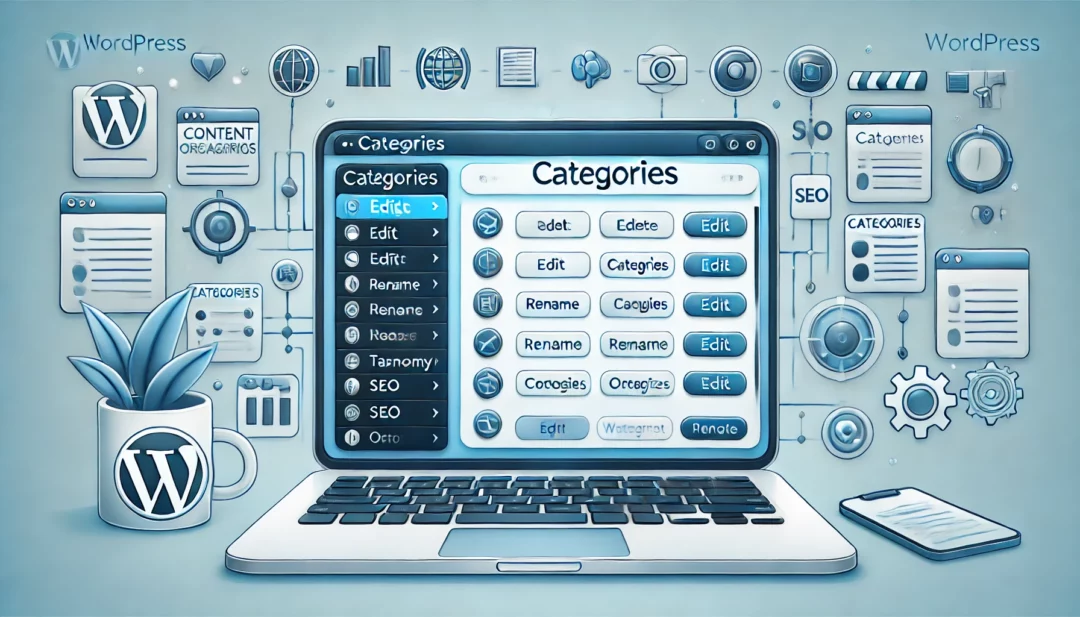
Managing your WordPress categories doesn’t have to be complicated. Whether you’re refining your blog’s structure or updating outdated labels, knowing how to edit categories is essential for keeping your content organized and user-friendly. With just a few simple steps, you can modify category names, descriptions, or even assign posts to different categories.
Understanding Categories In WordPress
Categories in WordPress help you group related posts, improving content organization and site navigation. They act as broad classifications, providing structure for your blog and aiding in search engine indexing. Proper category management ensures visitors easily find relevant content.
Features of Categories
- Hierarchy Support: Categories can have parent and child relationships for more detailed classifications. For example, “Recipes” (parent) can include “Desserts” and “Appetizers” as child categories.
- Default Category: WordPress assigns unclassified posts to a default category, usually named “Uncategorized.” You can rename this or set a different category as the default.
- Customizable Options: You can edit names, slugs (URL-friendly names), and descriptions for each category to match your content strategy.
- Improved Navigation: Categories help readers find related posts on specific topics quickly.
- SEO Advantages: Search engines use category structures to understand your site’s content hierarchy.
- Content Management: They make managing and updating blog content easier by grouping similar posts.
The better your category structure, the more seamless your blog’s user experience becomes.
Importance Of Organizing Categories
Organizing categories in WordPress creates a streamlined content structure, improving site navigation for both users and search engines. Categories group related posts, ensuring visitors find relevant content quickly and efficiently.
Enhances User Experience
Clear categories guide visitors through your site, minimizing confusion. For example, in a cooking blog, a “Desserts” category allows users to locate dessert recipes easily without searching through unrelated content.
Improves SEO Rankings
Search engines analyze category structures to understand your site’s content better. Properly grouped categories, such as “Tech Reviews” and “How-To Guides,” can help search engines index your site effectively, increasing visibility and rankings.
Simplifies Content Management
Organized categories make managing your posts manageable. For instance, updating outdated content within a specific category like “Travel Tips” ensures consistency and relevance across related posts.
Supports Hierarchical Relationships
Parent and child categories provide additional clarity. For example, under a parent category “Fitness,” child categories like “Yoga” and “Strength Training” improve content segmentation, helping users drill down to specific topics.
Optimizes Default Category Usage
Replacing the generic “Uncategorized” default category with a relevant one ensures unclassified posts don’t disrupt site organization. Assigning a default category like “General Updates” can maintain order even for uncategorized content.
Boosts Engagement and Page Views
Users exploring well-defined category pages spend more time on your site. For example, an “E-Books” category showcasing all downloadable resources encourages further interaction, improving page views and session duration.
Steps To Edit Categories In WordPress
Editing WordPress categories is a straightforward process that helps you maintain an organized content structure. Follow these steps to manage your categories effectively.
Accessing The Categories Section
Navigate to the WordPress Dashboard. From the menu on the left, select Posts, then click Categories. This opens the Categories section, where all existing categories are listed. Use this section to view, edit, add, or delete categories.
Editing An Existing Category
In the Categories section, locate the category you wish to edit. Hover over the category name and select Edit.
- Modify Details: Update the Name, Slug (URL), or Description fields. For instance, change the category name to better represent the content or update the slug for improved SEO.
- Save Changes: After making modifications, click the Update button to save.
Ensure the changes align with your blog’s structure and content strategy.
Adding A New Category
At the top of the Categories section, locate the Add New Category form. Enter the necessary details:
- Name: Provide a clear and relevant category name.
- Slug: Add a clean, lowercase URL (optional; WordPress auto-generates if blank).
- Parent Category: Select an existing category as the parent (if applicable) to create a hierarchy.
- Description: Add a brief description for the category (optional).
Click Add New Category to finalize.
Creating categories in advance helps streamline post assignments and maintain consistency.
Deleting Unnecessary Categories
In the Categories section, identify the category you want to remove. Hover over its name and click Delete. A confirmation prompt appears if the category contains posts.
- Reassign Posts: WordPress automatically assigns posts from the deleted category to the Default Category. Update this if necessary.
- Confirm Deletion: Proceed with the deletion by confirming the prompt.
Avoid deleting categories central to navigation or SEO unless replacements are fully implemented.
Regularly managing unused categories keeps your content structure clean and efficient.
Best Practices For Managing WordPress Categories
Using effective strategies for managing WordPress categories makes your website structured, SEO-friendly, and user-focused. Below are practical recommendations for maintaining clear and functional categories.
Keeping Categories Clear And Concise
Define category names clearly to avoid confusion. Use short, descriptive names that accurately represent the content, like “Web Design” instead of “Things About Designing Websites.” Clear names improve user navigation and make your site structure intuitive.
Limit the number of categories to 8–10 major ones to maintain simplicity. If you need more organization, use hierarchical relationships such as parent and child categories to group similar topics. For instance, a parent category like “Tech Reviews” can have child categories like “Mobile” or “Laptops.”
Avoiding Duplicate Or Irrelevant Categories
Consolidate categories with overlapping meanings to prevent redundancy. If both “Travel Guides” and “Tourist Tips” cover the same content type, merge them into one clearer category. Maintaining unique, distinct categories enhances site usability and avoids visitor frustration.
Delete irrelevant categories that don’t fit your niche or content focus. Double-check for unassigned posts and move those to appropriate categories before deleting. Avoid quick deletions, as they may break connections or create internal errors.
Regularly Updating Categories
Review your categories every 3–6 months to match your evolving content strategy. Focus on active categories and archive deprecated ones. Keeping a well-updated structure boosts your site’s SEO performance by ensuring keywords and content align with current trends.
Monitor visitor behavior using tools like Google Analytics to see which category pages get the most traffic. Refine underperforming categories by updating descriptions, slugs, or grouping smaller categories together to optimize navigation and engagement.
Common Mistakes To Avoid
Avoiding common mistakes when editing WordPress categories ensures a well-organized, SEO-friendly site. Missteps can disrupt navigation, harm SEO, or confuse visitors, making careful management essential.
Ignoring SEO Impact
Affecting SEO performance negatively often occurs when category settings are overlooked. Categories contribute to your site’s content hierarchy, directly influencing search engine indexing. If duplicate or generic names (e.g., “Category 1”) are used, visitors and crawlers may struggle to understand your site’s structure. Ensure each category has a unique, descriptive name and optimized slug. For example, instead of “Blog”, use “Web Development Tips” to include targeted keywords.
Neglecting meta descriptions for category pages also impacts SEO. Many themes support category descriptions, which serve as meta descriptions in search results. Always write keyword-rich descriptions aligned with each category’s content. Additionally, updating categories without adjusting related permalinks leads to broken links. Use a redirect plugin to maintain link integrity after slug changes.
Overloading With Too Many Categories
Overcomplicating navigation happens when too many categories are created. Large category lists (e.g., 15–20) dilute content focus and overwhelm visitors. Limit primary categories to 8–10 for a streamlined structure. If content overlaps multiple categories, review posts and consolidate them where appropriate. For instance, merge “How-To Guides” and “Tutorials” into one if their posts overlap significantly.
Assigning posts to excessive categories also reduces user experience and dilutes SEO. Stick to one or two relevant categories per post for clarity. Regularly audit your category list and remove unused or redundant options. Use subcategories carefully to maintain organization without over-fragmenting your structure. For example, “SEO” as a parent category with subcategories like “On-Page SEO” and “Keyword Strategies” avoids clutter.
Conclusion
Effective category management in WordPress is a game-changer for both user experience and SEO. By keeping your categories organized, concise, and regularly updated, you create a blog that’s easy to navigate and optimized for search engines.
Whether you’re editing existing categories or creating new ones, a thoughtful approach ensures your content remains accessible and engaging. With consistent effort, you’ll maintain a streamlined structure that benefits both your readers and your site’s performance.
Frequently Asked Questions
What are categories in WordPress?
Categories in WordPress are a way to group related posts under broad topics. They help organize content, improve user navigation, and enhance SEO by enabling search engines to understand your site’s structure.
Why is managing WordPress categories important?
Properly managing categories improves user experience by streamlining navigation. It ensures content is easy to find, enhances SEO rankings, and simplifies blog maintenance by keeping posts organized.
How do I edit a WordPress category?
To edit a category, go to your WordPress Dashboard, click “Posts,” then “Categories.” Select the category to modify, edit its name, slug, or description, and save changes.
Can I delete WordPress categories?
Yes, you can delete categories, but be cautious as it may affect site navigation and SEO. Reassign posts from the deleted category to another to avoid issues.
How many categories should my blog have?
It’s recommended to limit major categories to 8–10, ensuring focus and clarity for both visitors and search engines.
What’s the difference between a category and a tag in WordPress?
Categories organize posts into broad topics, while tags provide specific details about the content. Categories are hierarchical; tags are not.
How does category management impact SEO?
Proper category management improves SEO by creating a clear content structure. It helps search engines better index your site, leading to higher rankings.
Can I create subcategories in WordPress?
Yes, WordPress supports hierarchical categories, allowing you to create subcategories (child categories) under parent categories for better organization.
What happens if I don’t assign a category to a post?
Posts without assigned categories are automatically placed under the Default Category (usually “Uncategorized”). You can rename the Default Category for more relevance.
How often should I update my blog’s categories?
It’s a good practice to review and update categories every 3–6 months to align with evolving content, SEO trends, and visitor preferences.
How do I optimize category pages for SEO?
Write unique, keyword-rich meta descriptions for category pages, use descriptive names, and include relevant internal links to boost SEO performance.
Is it okay to use duplicate category names?
No, using duplicate or generic names can confuse visitors and reduce SEO effectiveness. Always use distinct, descriptive names for your categories.
What should I do with unused or redundant categories?
Regularly audit and delete unused or redundant categories to maintain a clean structure. Reassign posts to appropriate categories if necessary.
Can I assign a post to multiple categories?
Yes, but assigning posts to more than one or two relevant categories can dilute focus and negatively impact user experience.
How do I prevent common mistakes when handling WordPress categories?
Avoid duplicate names, ensure slugs and links maintain integrity, minimize categories to 8–10, and write keyword-rich meta descriptions for each category page.



